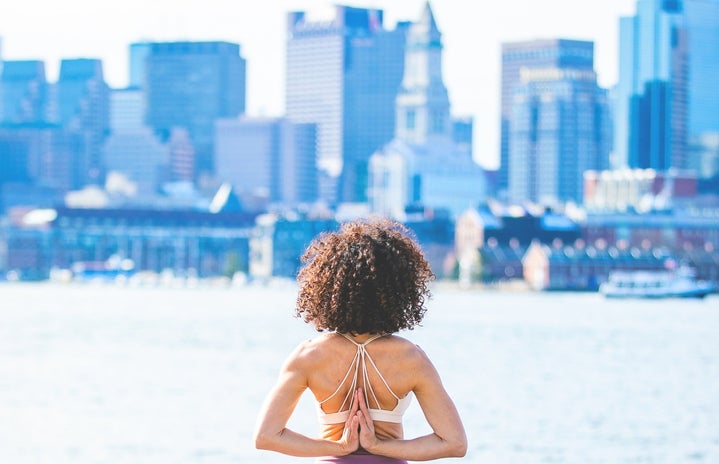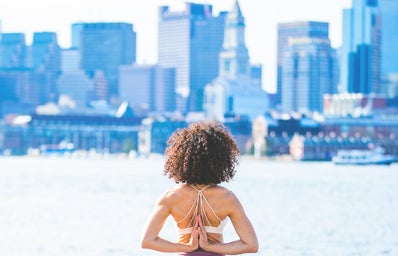Yes, I know, everyone’s mother, friend, and quirky aunt has been telling you to meditate for years. But seriously, it can do wonders for a person mentally, emotionally, and even physically. As a martial artist, I’ve been meditating since I was six, and as a martial arts instructor, I’ve been teaching people of all ages how to better meditate for a little over five years. Now, that’s not to say that I was good at it when I was six—if you asked my instructor, I’m sure she could tell you some pretty funny stories about my lack of focus. But that’s the point, meditation is difficult and I doubt even the Dalai Lama was good at meditating when he first started. That being said, be kind and gentle with yourself when you first begin. Meditation is a skill and your mind is a muscle. For instance, think of meditation like dribbling a ball. When you first start dribbling you’re bad at it, but that’s to be expected of anything you’ve never done before. You have to really focus on everything your body is doing and when your focus breaks you lose control over the ball. In order to dribble without thinking about it, you need to practice repeatedly and allow the skill to become a muscle memory. Meditation is the same, when a person first begins to meditate they’re not used to quieting their mind and thinking of nothing, it’s difficult. But if you stay dedicated and continue to practice it will do wonders for your overall wellness.
There are many different types and ways of meditating, here are some general guidelines to get you going. I’d recommend trying them all out and seeing which work best for you. Also, don’t be afraid to change or combine any of these tips—it’s all about you as an individual and syncing up your mind and body.
- Get comfortable
-
There are all sorts of different types of meditations: manifestation, sleep, relaxation, and balance to name a few. But, for all of them, it’s important that you situate yourself in a comfortable position. If you’re continuously feeling twinges of discomfort it’ll be even harder to focus your mind. I’d recommend sitting legs crossed, kneeling, or laying on your back. When you’re sitting or kneeling it’s good to have your back straight and hands resting gently on your knees. If you choose to lay down, try placing your flat on either side.
- Close your eyes
-
When people first start meditating they aren’t normally used to clearing their minds. Especially in this day and age with a million and one things going on, the world is full of distractions and your mind will want to latch on to each and every one. One way to keep your mind focused is to simply close your eyes. With that action, your eyelids become a barrier that helps you to separate yourself a little more from the outside world.
- Meditation isn’t breathing; it’s controlling your breath
-
Don’t think of meditation as just sitting and breathing. How you should breathe when you meditate is not how you breathe throughout the day. When most people breathe, their chest rises and falls as the air inflates their lungs. The type of breath you use when meditating is commonly referred to as belly breathing. When you meditate, breathe in through your nose and out through your mouth. As you breathe in, imagine your belly is a balloon and you need to inflate it. Feel your stomach expand and push out against your waistband. Then, as you breathe out, the balloon slowly loses its air and your belly returns to normal. A way to practice belly breathing is to place one hand on your chest and one on your belly. Breathe in normally and feel the hand on your chest rise. Next, try belly breathing. Visualize the balloon inflating and deflating, feel your stomach expand against your clothes and as you do notice how the hand on your stomach rises and falls. When you meditate, try to only breathe through your belly—continue with this technique and eventually you’ll be able to let the imagery fade away and simply focus on the feeling of the balloon inflating and deflating that your body has now become accustomed to.
Another breathing technique is the magic three. The magic three will help you sync into a rhythm and focus your mind internally. For this technique time your breathing to three seconds. That means you should breathe in for three seconds, hold your breath for three seconds, breathe out for three seconds, and keep air out of your lungs for three seconds. To visualize this picture the air flowing through your body as you breathe. Inhale: 1, 2, 3, and the air flows in through your nose filling the cavities of your lungs. Hold: 1, 2, 3, and the air hovers in your lungs at the very uppermost section. Breathe out: 1, 2, 3, and the air sinks down in your lungs and is exhaled out. This is then repeated, after using this technique your body will become accustomed to the pattern, and you’ll no longer need to count in your head. Instead, simply focus on your breath and how the air is traveling through the pathways of your body.
Finally, another one of my favorite techniques—especially when it’s hot out or right after a workout—is cool air vs. sticky air. With this strategy, you can use either of the visualization techniques I mentioned before (balloon or pathways), except this time your focus should be on how the air feels as it enters and exits your body. While you’re breathing in, focus on the feeling of the cool air as it goes in your nostrils filling your mouth, hitting the back of your throat, and traveling down to your lungs. Next, exhale and as you do, focus on how the air has become sticky, and exhale the heat to leave yourself refreshed.
- Root yourself
-
If you’ve chosen a sitting position as I said earlier, you’ll want to keep your back straight and your palms gently resting on your knees. You don’t need your back to be ramrod straight, it’s likely that won’t be comfortable. Instead, think about lengthening your spine. Release the tension in your back and roll your shoulders back a few times.
Now, as you breathe in, imagine there is a string attached to the top of your head and as the air comes in strong, it’s pulling upwards, and your head and spine are lifted by the string. As you breathe out the string loses all tension and, without slouching, sink downwards and root into the ground below you. In this instance, you are a tree and as you breathe out your tailbone grows into the ground effectively rooting you to the floor below.
Another visualization technique you can try is, as you breathe in, and the string lifts you up, allow the space between each vertebra to grow and expand upwards, then, as you breathe out through your mouth that space shrinks and compacts together. Your body weight rises with each inhale and sinks with each exhale.
- Extend each of your senses, let them reach out to the world
-
Meditation is all about attuning your mind to your body—that includes your senses. Most of us rely on our eyesight, that’s just how our society is set up, but when you meditate you can practice expanding your other senses. After you’ve begun to regulate your breathing, keep your breath pattern steady and begin focusing on your hearing. Maybe you hear the creak of floorboards, cars outside, or rain. You can also focus on your sense of smell, how does the air smell when you breathe it in? Finally, you can focus on your sense of touch. Notice how the floor feels beneath you. Pay attention to how your body is balancing itself and how the air feels on your skin.
- Check-in with your body
-
This tip is similar to focusing on your sense of touch. After you have felt how your body is in relation to the environment, turn that attention inwards. Many of us are introspective, but this sense and feeling normally begins and ends with our thoughts. When you meditate, try focusing on how your body feels. Begin with your head if you’ve begun to slouch at all while you’ve been meditating, and let the string pull your neck back up straight and allow your spine to follow suit. You can even roll your shoulders to ease tension while you check your posture. Now scan the rest of your body and take note of any places that feel tight or enflamed, and make a note to come back to them at the end of your meditation to stretch them out or massage them. Extend your sense though your limbs, first your arms all the way down to your fingertips and then your legs down to your toes.
- Relax
-
This is the most important part: relax. Try to feel at ease with yourself while you meditate. When you focus your mind, clear it of any thoughts of the future or past, try to block out all distractions using the techniques above.
When you first begin meditation will be difficult, it’s hard to clear your mind. Clearing your mind and centering yourself is a skill that takes practice and focus. So, it’s important that you be kind to yourself. Among meditations many benefits, one is that meditation helps to improve your overall wellness and balance. Part of wellness is understanding you are not perfect and allowing yourself to make mistakes. Something that people can find really helpful is guided meditations. Some of my favorites are Morning Miracle Meditation – Daily Morning



